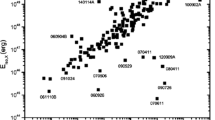Abstract
The burst component of the solar X-ray flux in the soft wavelength range 2 < λ < 12 Å observed from Explorer 33 and Explorer 35 from July 1966 to September 1968 was analyzed. In this period 4028 burst peaks were identified.
The differential distributions of the temporal and intensity parameters of the bursts revealed no separation into more than one class of bursts. The most frequently observed value for rise time was 4 min and for decay time was 12 min. The distribution of the ratio of rise to decay time can be represented by an exponential with exponent -2.31 from a ratio of 0.3 to 2.7; the maximum in this distribution occurred at a ratio of 0.3. The values of the total observed flux, divided by the background flux at burst maximum, can be represented by a power law with exponent -2.62 for ratios between 1.5 and 32. The distribution of peak burst fluxes can be represented by a power law with exponent - 1.75 over the range 1–100 milli-erg (cm2 sec)−1. The flux time integral values are given by a power law with exponent -1.44 over the range 1–50 erg cm−2.
The distribution of peak burst flux as a function of Hα importance revealed a general tendency for larger peak X-ray fluxes to occur with both larger Hα flare areas and with brighter Hα flares. There is no significant dependence of X-ray burst occurrence on heliographic longitude; the emission thus lacks directivity.
The theory of free-free emission by a thermal electron distribution was applied to a composite quantitative discussion of hard X-ray fluxes (data from Arnoldy et al., 1968; Kane and Winckler, 1969; and Hudson et al., 1969) and soft X-ray fluxes during solar X-ray bursts. Using bursts yielding measured X-ray intensities in three different energy intervals, covering a total range of 1–50 keV, temperatures and emission measures were derived. The emission measure was found to vary from event to event. The peak time of hard X-ray events was found to occur an average of 3 min before the peak time of the corresponding soft X-ray bursts. Thus a changing emission measure during the event is also required. A free-free emission process with temperatures of 12–39 × 106K and with an emission measure in the range 3.6 × 1047 to 2.1 × 1050 cm−3 which varies both from event to event and within an individual event is required by the data examined.
Similar content being viewed by others
References
Arnoldy, R. L., Kane, S. R., and Winckler, J. R.: 1968, ‘An Atlas of 10–50 keV Solar Flare X Rays Observed by the OGO Satellites 5 September 1964 to 31 December 1966’, University of Minnesota Cosmic Ray Technical Report CR-108, January 1968.
Carlquist, P.: 1968, ‘Solar Flares Caused by High Impedance Regions in Current Filaments’, Royal Institute of Technology Research Report No. 68-11, Stockholm, May 1968.
Chubb, T. A., Friedman, H., and Kreplin, R. W.: 1964, ‘Spectrum of Solar X-Ray Emission from 2–20 keV during Subflare Activity’, in P. Muller (ed.), Space Res. 4, 759.
Culhane, J. L.: 1969, ‘Thermal Continuum Radiation from Coronal Plasmas at Soft X-Ray Wavelengths’, Monthly Notices Roy. Astron. Soc. 144, 375.
Culhane, J. L. and Phillips, K. J. H.: 1969, ‘Solar X-Ray Bursts at Energies Less Than 10 keV Observed with OSO 4’, Mullard Space Science Laboratory Research Report, University College, London.
De Jager, C. and Kundu, M. R.: 1963, ‘A Note on Bursts of Radio Emission and High Energy (>20 keV) X-Rays from Solar Flares’, in P. Muller (ed.), Space Res. 3, 836.
Drake, J. F.: 1970, ‘Soft Solar X-Ray Burst Characteristics’, University of Iowa Research Report 70-1, January 1970.
Drake, J. F., Gibson, Sr., J., O.S.B., and Van Allen, J. A.: 1969, ‘Iowa Catalog of Solar X-Ray Flux (2–12 Å)’, Solar Phys. 10, 433.
Elwert, G.: 1968, ‘The Significance of the Polarization of Solar Short-Wavelength X-Rays’, in K. O. Kiepenheuer (ed.), ‘Structure and Development of Solar Active Regions’, IAU Symp. 35, D. Reidel, Dordrecht, Holland.
Gibson, Sr., J., O.S.B.: 1969, ‘The Correlation of X-Ray Radiation (2–12 Å) with Microwave Radiation (10.7 cm) from the Non-Flaring Sun’, Ph.D. Thesis, University of Iowa, Iowa City, Iowa.
Harries, J. R.: 1968, ‘Variable X-Ray Fluxes from Celestial Objects’, Ph.D. Thesis, University of Adelaide, South Australia.
Hudson, H. S., Peterson, L. E., and Schwartz, D. A.: 1969, ‘The Hard Solar X-Ray Spectrum Observed from the Third Orbiting Solar Observatory’, Astrophys. J. 157, 389.
Kane, S. R.: 1967, ‘Application of an Integrating Type Ionization Chamber to Measurements of Radiation in Space’, University of Minnesota Cosmic Ray Technical Report CR-106.
Kane, S. R.: 1969, ‘Observations of Two Components in Energetic Solar X-Ray Bursts’, Astrophys. J. 157, L139.
Kane, S. R. and Winckler, J. R.: 1969, ‘An Atlas of 10–50 keV Solar Flare X-Rays Observed by the OGO Satellites 1 January to 31 December 1967’, University of Minnesota Cosmic Ray Technical Report CR-134, April 1969.
Kreplin, R. W., Moser, P. J., and Castelli, J. P.: 1969, ‘Flare X-Ray and Radio Wave Emission’, paper presented at the XIIth Plenary Meeting of COSPAR, Prague, Czechoslovakia, May 1969.
Meekins, J. F., Kreplin, R. W., Chubb, T. A., and Friedman, H.: 1968, ‘X-Ray Line and Continuum Spectra of Solar Flares from 0.5 to 8.5 Angstroms’, Science 162, 891.
Neupert, W. M.: 1968, ‘Comparison of Solar X-Ray Line Emission with Microwave Emission during Flares’, Astrophys. J. 153, L59.
Neupert, W. M., Gates, W., Swartz, M., and Young, R.: 1967, ‘Observation of the Solar Flare X-Ray Emission Line Spectrum of Iron from 1.3 to 20 Å’, Astrophys. J. 149, L79.
Ohki, K. I.: 1969, ‘Directivity of Solar Hard X-Ray Bursts’, Solar Phys. 7, 260.
Pinter, S.: 1969, ‘Longitudinal Distribution of X Bremsstrahlung on the Solar Disk’, Solar Phys. 8, 142.
Rugge, H. R. and Walker, A. B. C. Jr.: 1968, ‘Solar X-Ray Spectrum below 25 Å’, in A. P. Mitra, L. G. Jacchia, and W. S. Newman (eds.), Space Res. 8, 439.
Solar-Geophysical Data, issued by the Institutes for Environmental Research, U.S. Department of Commerce, Nos. 264–295, August 1966–March 1969.
Takakura, T. and Kai, K.: 1966, ‘Energy Distribution of Electrons Producing Microwave Impulsive Bursts and X-Ray Bursts from the Sun’, Publ. Astron. Soc. Japan 18, 57.
Teske, R. G.: 1969, ‘Observation of the Solar Soft X-Ray Component; Study of its Relation to Transient and Slowly-Varying Phenomena Observed at Other Wavelengths’, Solar Phys. 6, 193.
Van Allen, J. A.: 1967a, ‘The Solar X-Ray Flare of July 7, 1966’, J. Geophys. Res. 72, 5903.
Van Allen, J. A.: 1967b, ‘Catalog of Solar X-Rays’, Solar-Geophysical Data, issued by the Institutes for Environmental Research, U.S. Department of Commerce, July 1967–August 1969.
Author information
Authors and Affiliations
Additional information
Now at Department of Astrophysical Sciences, Princeton University, Princeton, New Jersey.
Rights and permissions
About this article
Cite this article
Drake, J.F. Characteristics of soft solar X-ray bursts. Sol Phys 16, 152–185 (1971). https://doi.org/10.1007/BF00154510
Revised:
Issue Date:
DOI: https://doi.org/10.1007/BF00154510




